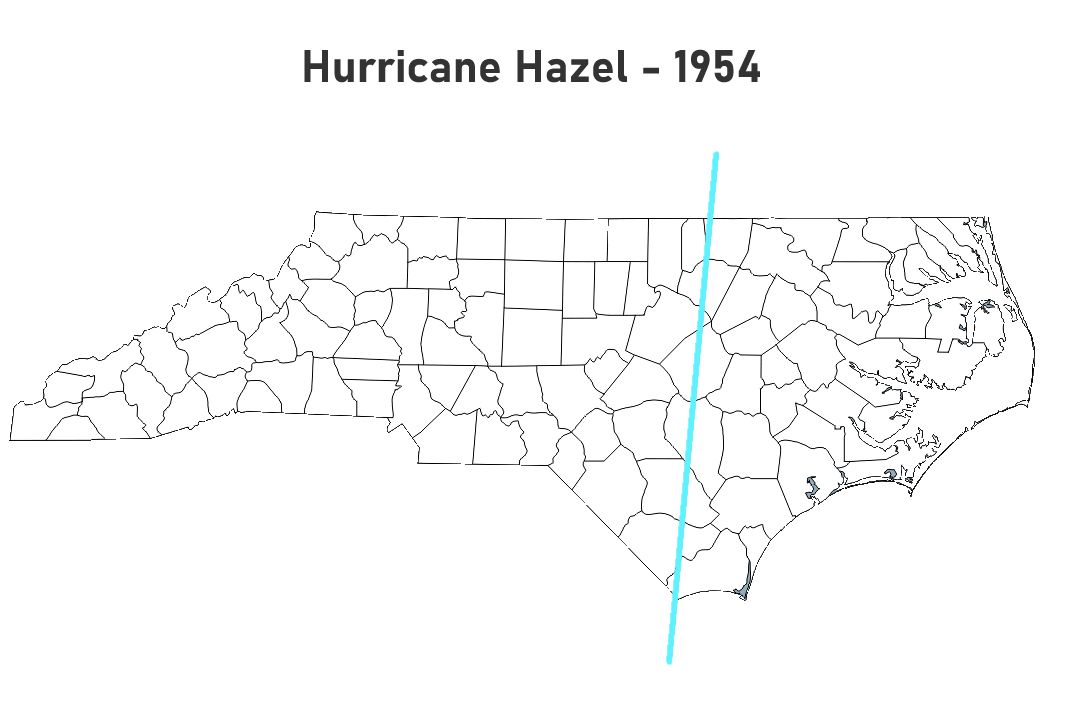In October 1954, a much smaller version of the Raleigh Fire Department answered dozens of calls as Hurricane Hazel passed across the state. The department–with seven engine companies and two truck companies–had one of their busiest weekends ever, said newspapers.
For four decades, Hazel was recognized as the benchmark of tropical weather in this part of the country. Hurricane Fran passed that benchmark in 1996. What did the fire department response look like, when Hazel blew through Raleigh?
Fire Calls During Hurricane Hazel
From the Monday, October 18, 1954 edition of the Raleigh Times:
Raleigh firemen experienced one of their busiest weekends as a result of damage wrought by Hurricane Hazel.
The following telephone calls were answered on Friday:
- 8:05 a.m., 23 Bragg Street, electric wire, no damage;
- 10:04 a.m., 1206 Park Drive, rug on fire, damage not estimated;
- 11:30 a.m., 20 E. Cabarrus Street, electric wires, no damage;
- 1:40 p.m., 714 Glenwood Avenue, electric wires, no damage:
- 2:05 p.m., Lenior and Salisbury, electric wires, no damage;
- 2:35 p.m., Colleton Road, house, damage not estimated;
- 3:00 p.m., 500 S. Salisbury Street, tree on auto, damage no estimated;
- 3:55 p.m., Carolina Buck Company, use of ladder needed;
- 6:40 p.m., 400 block Oberlin Road, electric wires, no damage;
- 7:15 p.m., 908 Fayetteville Street, oil stove, no damage;
- 8:40 p.m., Cabarrus and Cutler, electric wires, no damage;
- 9:00 p.m., S. East Street, electric wires, no damage;
- 10:15 p.m., 500 block Salisbury Street, tree on fire, no damage;
- 10:53 p.m., 128 N. Harrington Street, inspection;
- 11:30 p.m., Bloodworth and Edenton Street, inspection
Calls on Saturday included:
- 7.31 a.m., Box 313 alarm at Manly and Pugh Streets, oil stove, no damage;
- 2:10 p.m., Mullins Lane, electric wires, no damage;
- 5:32 p.m., Box 241 alarm at Martin and State Streets, oil stove, damage not estimated;
- 7:17 p.m., 2931 Wade Avenue, electric wires, no damaged;
- 8:39 p.m., 109 N. Boylan Avenue, electric wires, no damage;
- 8:46 p.m., same as above;
- 11:36 p.m., Franklin and Person Streets, brush and smudge pot on fire, no damage.
Sunday’s calls included:
- 2:45 a.m., 2302 Byrd Street, electric motor, no damage;
- 9:05 a.m., 319 S. Dawson, inspection;
- 10:12 a.m., Sawyer Lane, chimney, no damage;
- 1:40 p.m., 400 block Peace, bus on fire, no damage;
- 12:41 to 421 N. Bloodworth Street, look for lost child;
- 2:52 p.m., to 13 Maiden Lane, tree about to fall, no damage.
Then and Now
As for the size of the Raleigh Fire Department in 1954:
- In 1950, RFD had 6 stations protecting 10.9 square miles and 65,679 residents
- Starting in 1950, RFD had two shifts, working 24 on, 24 off
- That same year, 83 new personnel were added.
- In 1954, city had six stations with 7 engines, 1 aerial, 1 service truck, and a two-piece rescue squad.
By comparison, Raleigh FD in 2022:
- 28 stations protecting 142.902 square miles and 388,926 residents
- 626 uniformed and civilian personnel
- 29 engines (including two rescue pumpers called squad companies), 9 ladders, 1 rescue, 5 battalion chiefs, 1 operations division chief, and various haz-mat, USAR, and other special units.
- 47,943 calls in 2021.
Hurricane Hazel Background
On October 15, 1954, Hurricane Hazel made landfall in Brunswick County, NC. It was the eighth Atlantic hurricane that year. The storm surge at the coast was the greatest in the state’s recorded history. It struck at the exact time of highest lunar tide of year. The coastal regions of the state received some of most destructive winds ever, with estimates in several locations of 150 mph gusts. At Raleigh-Durham Airport, gusts to 90 mph were recorded around 1:30 p.m.
In North Carolina, nineteen people were killed and over 200 were injured. Destroyed were 15,000 homes and structures, along with 39,000 structures damaged. Total of 30 counties had major damages. The total estimated property losses were $136 million. The totals for the United States, Canada, and Haiti combined were over 600 people dead and an estimated $350 million in property damage. Source: North Carolina’s Hurricane History, Third Edition by Jay Barnes, UNC Press, 2001
This is an updated version of a posting from August 25, 2011. An earlier version of this posting was published on FireNews.net on September 26, 2003, after Hurricane Isabel passed through the Carolinas.
